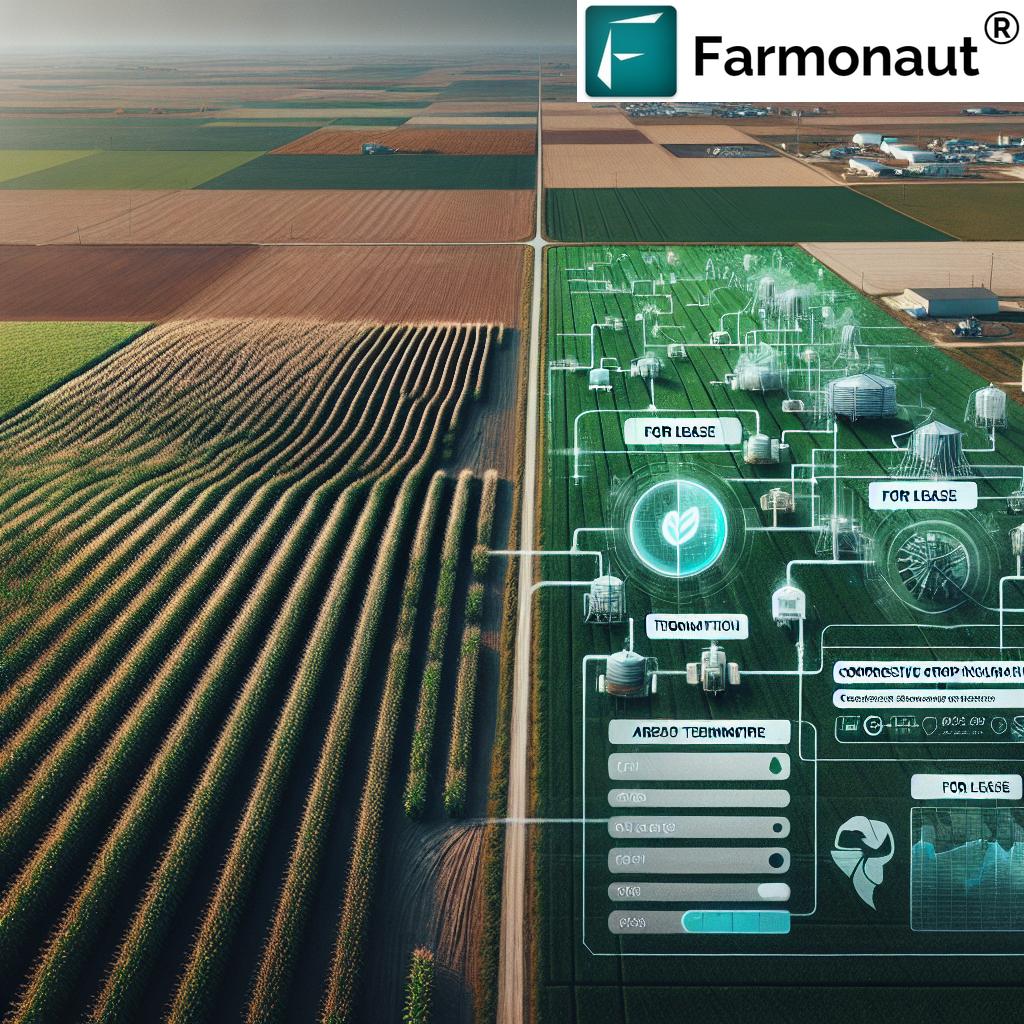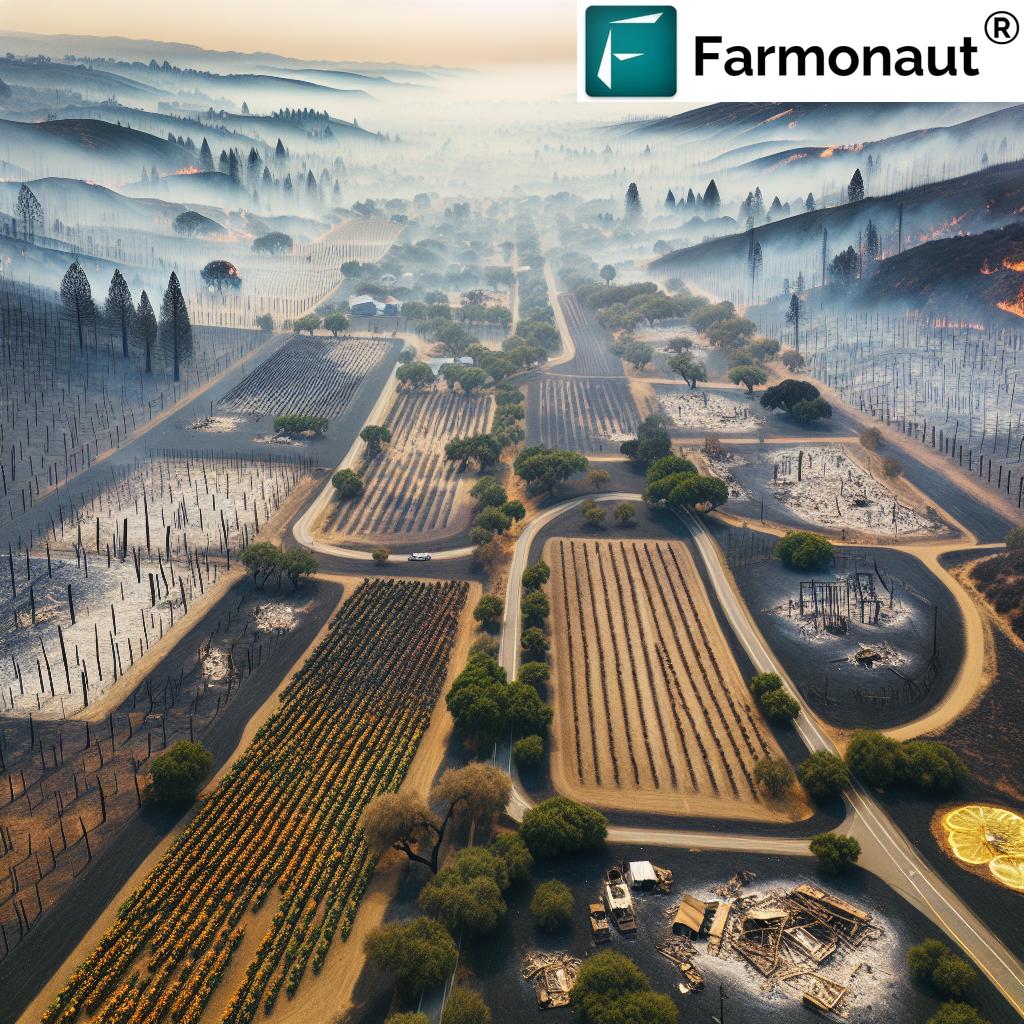North America Agriculture 2025: Top Farming Innovations
Table of Contents
- Introduction: The State of North America Agriculture in 2025
- 2025 AgriTech Trivia
- Comparative Overview of Top Farming Innovations
- Key Drivers of Agricultural Transformation in North America
- Technological Breakthroughs Shaping Agriculture in North America
- Precision Agriculture: Data-Driven Decisions for Better Yields
- Artificial Intelligence, IoT & Smart Farming
- Regenerative and Sustainable Practices
- Shifting Market Dynamics & Consumer Trends
- Regional Insights: U.S., Canada, and Mexico
- Farmonaut’s Role in North America’s Agricultural Innovation
- Midway Trivia
- Frequently Asked Questions (FAQs)
- Conclusion & Future Outlook
“By 2025, over 60% of North American farms will use AI-powered precision agriculture technologies for crop management.”
Introduction: The State of North America Agriculture in 2025
North America agriculture in 2025 stands as a beacon of progress, blending traditional farming wisdom with groundbreaking technological advancements. This sector remains a critical pillar for the continent’s economy, food security, and environmental health, encompassing a vast range of agricultural practices, livestock operations, and diverse crop cultivation. From the lush prairies of the Midwest United States, through the extensive Canadian Prairies, to the fertile, subtropical fields of Mexico, the region exemplifies agricultural diversity.
In 2025, agriculture of North America is undergoing fast-paced evolution powered by precision agriculture, digital innovation, climate-smart practices, and shifting consumer demands. In this comprehensive blog, we explore the pivotal innovations and trends shaping the future of north american agriculture.
Comparative Innovation Overview: Top Technologies in North America Agriculture 2025
| Innovation Name | Technology Type | Estimated Adoption Rate | Projected Impact | Geographic Focus |
|---|---|---|---|---|
| AI-Powered Precision Agriculture Systems | AI, Big Data | 60%+ farms (2025) | +15% Yield, -20% Input Costs | U.S. Midwest, Canadian Prairies |
| Satellite-Based Crop Health Monitoring | Satellite, Remote Sensing | 30-50% of large farms | Improved pest & water management, up to 18% resource savings | Entire continent |
| Vertical and Urban Farming | Hydroponics, Controlled Environment | 24% annual growth rate | +200% productivity per sq.ft., year-round local food | United States & Canada urban centers |
| Regenerative Agriculture Techniques | Sustainable Practices | 20-30% of farms | Soil carbon increase, erosion reduced by 50% | U.S. Northern Plains, Ontario, Quebec, Central Mexico |
| Blockchain Product Traceability | Blockchain | Adopted by major agri-exporters and retailers | Enhanced supply chain transparency, increases consumer trust | US, Canada, Mexico export channels |
| Autonomous Farm Machinery | Robotics, GPS | 40% of large operations | Labor savings, up to +10% yield from timely operations | Large-scale farms, US Great Plains, Canada |
Key Drivers of Agricultural Transformation in North America
The agriculture of North America in 2025 is propelled by a synergy of change agents:
- Technological Advancements: Including satellite monitoring, artificial intelligence (AI), the Internet of Things (IoT), drone technology, and advanced data analytics to help optimize yields, use resources efficiently, and reduce waste.
- Sustainability Initiatives: Focus on regenerative agriculture, carbon footprint reduction, water management, and biodiversity maintenance.
- Shifting Market Dynamics: Changing consumer demands for traceability, healthier food products, organic, and locally-sourced options.
- Climate Adaptation: Farmers responding to variable climates, unpredictable weather, and heightened pest/disease pressures.
- Trade & Policy: Regional agreements (USMCA), support programs, and evolving regulatory standards.
Technological Breakthroughs Shaping Agriculture in North America
North american agriculture has witnessed a technology revolution. Key innovations are transforming every link in the agricultural value chain:
1. Satellite-Based Monitoring & Remote Sensing
Utilizing multi-spectral images, satellites track crop health, soil conditions, water levels, and even forecast disease spread. This technology is now central to major commercial farms and regional initiatives, helping producers optimize inputs, improve yields, and minimize environmental impact. For instance, Farmonaut’s platform offers large-scale farm management solutions that leverage real-time satellite imagery, enabling farmers to detect crop stress and make timely interventions.
2. AI-Driven Advisory Systems for Precision Farming
AI now powers expert advisory tools, weather-based warnings, and predictive modeling, helping farmers address challenges from pest outbreaks to nutrient deficiencies. Farmonaut’s Jeevn AI, for example, analyzes satellite and field data to recommend site-specific actions, fostering higher productivity for a wide range of crops and reducing risk.
3. Blockchain-Based Traceability Solutions
The demand for traceable food systems is at its peak. Blockchain is bringing transparency to food supply chains, allowing buyers to verify the exact journey of their food from field to shelf. This also ensures brand trust and compliance. Farmonaut’s product traceability platform is instrumental in helping producers and corporate clients secure and verify the provenance of agri-products.
4. Autonomous and Electric Farm Machinery
Robotics and electric tractors are increasingly common on large operations in the U.S. and Canada. These machines, equipped with GPS navigation and smart sensors, reduce labor dependency while operating with optimal timing and efficiency.
5. IoT Sensors & Real-Time Environmental Monitoring
Farms deploy connected sensors in soil, irrigation channels, and storage facilities. These relay humidity, temperature, nutrient, and crop growth data in real time, helping agribusinesses react instantly and fine-tune every cultivation practice.
6. Vertical Farming & Controlled Environment Agriculture
Urban and peri-urban centers in North America are redefining food systems with vertical farming. These operations harness LED lighting, climate controls, and hydroponics to multiply yields and produce food closer to consumers in dense cities.
Precision Agriculture in North America 2025: Data-Driven Decisions for Better Yields
Precision agriculture remains at the heart of the north american agriculture innovation wave. It brings together satellite imagery, drone technology, field sensors, and AI analytics to target resources exactly where needed—reducing waste and maximizing crop output.
- GPS-Guided Equipment: Tractors equipped with GPS ensure accurate planting, fertilization, and harvesting—reducing overlap and unnecessary fuel use.
- Multispectral Drone Monitoring: Drones fly over fields, detecting stressed plants, mapping pest infestations, and even applying targeted treatments.
- Variable Rate Technology (VRT): This enables seeders, sprayers, and spreaders to vary inputs according to field-specific needs, supported by digital soil maps and AI-generated prescriptions.
- Pest and Disease Forecasting: Satellite data coupled with on-ground sensors predict outbreaks, enabling precise yet minimal chemical use, which supports environmental health and compliance.
The impact is clear: Resource efficiency is at an all-time high, input and water usage are significantly reduced, and productivity soars across diverse crops—from corn, wheat, soybeans, to fruits and vegetables. Farmonaut’s carbon footprint tracking helps farmers and agribusinesses monitor emissions and align with regional sustainability goals.
Artificial Intelligence & IoT: Accelerating Smart Farming in North America
AI and the Internet of Things (IoT) are redefining agriculture of North America by making every decision, from planting to marketing, smarter. Here’s how:
- AI Decision Engines: These analyze inputs from satellites, sensors, and weather stations to guide irrigation schedules, fertilizer use, and harvest timing.
- Predictive Maintenance: Sensors embedded on machinery predict breakdowns, schedule service, and reduce costly downtime.
- Yield Mapping: AI and GPS data produce detailed yield maps down to the acre or meter—informing better planning for future seasons.
- Smart Irrigation Controls: Linking weather forecasts, real-time soil data, and moisture maps optimizes every drop of irrigation, curbing waste and bolstering resilience against drought, especially in Western U.S. and Mexican farms.
Farmonaut enables seamless integration of agronomic data, leveraging AI to deliver real-time crop health monitoring and actionable advisories through its Android and iOS apps, as well as browser-based platforms. Developers and enterprises can take advantage of Farmonaut’s API and developer documentation to build custom agri-solutions or integrate satellite monitoring into their own systems.
Regenerative & Sustainable Practices: North America’s Path to Resilience
Tackling climate challenges and sustaining soil health are top priorities for north america agriculture. Regenerative agriculture is gaining ground as a transformative movement across the continent. Techniques such as cover cropping, no-till/reduced tillage, crop rotation, integrated pest management, and agroforestry are being adopted to restore ecological balance and promote long-term productivity.
- Cover Cropping & Crop Rotation: Reduces soil erosion, fixes nitrogen, and discourages pest cycles, especially vital in the U.S. Midwest and Canadian Prairies.
- Reduced Tillage: Preserves soil structure, increases organic matter and carbon sequestration, and minimizes run-off.
- Integrated Pest Management: Deploys a combination of biological, chemical, cultural, and mechanical methods to suppress pests below economic thresholds, improving biodiversity.
- Water Conservation: Techniques like drip irrigation and managed aquifer recharge help sustain farming in arid regions of the U.S. Southwest and parts of Mexico.
Farmonaut’s carbon footprint monitoring and precision advisory solutions are helping producers follow these best practices, documenting impact and supporting compliance with sustainability programs across the continent. Explore how carbon footprinting can add value to your operations.
Shifting Market Dynamics & Consumer Trends in North America Farming
Evolving consumer demands are transforming markets. Preferences for healthy, organic, sustainably sourced, and locally produced food are fueling the rise of new farming models—community supported agriculture (CSA), direct-to-consumer sales, and traceable supply chains.
- Food Safety & Traceability: Blockchain enables full tracking from farm through processing, distribution, and final retail sale, supporting both compliance and consumer trust.
- Digital Marketplaces: Producers can market directly to consumers or specialty buyers—maximizing profit and offering transparent sourcing.
- Rise of Organic & Regenerative Products: These are surging in popularity, supporting smaller and mid-sized farms alongside large agribusinesses.
- Farm Plastic & Packing Innovation: Initiatives in Ontario and other regions are recycling farm plastics, closing the loop toward circular economy models.
Regional Insights: Adapting Innovations Across United States, Canada & Mexico
United States: The Innovation Powerhouse
The United States features some of the world’s largest commercial farms, especially throughout the fertile Midwest and Great Plains. Corn and soybeans dominate in rotation, while cotton, wheat, and specialty fruits and vegetables round out production. Key trends include:
- Wide adoption of precision farming technologies, drones, and satellite crop monitoring.
- Large-scale deployment of autonomous tractors, especially in row crop and cereal production.
- Transition to more sustainable pest and input management for long-term soil health.
- Expansion of regenerative practices and on-farm carbon footprint tracking.
Canada: Sustainability and Smart Input Management
Canada’s agricultural sector is characterized by its focus on wheat, canola, barley, and pulses, along with dairy, beef, and specialty crops on the Canadian Prairies. Sustainable management is central, with producers adopting crop rotation, reduced tillage, and precision nitrogen management.
- Investment in green ammonia fertilizer and AI-powered input management to reduce emissions.
- Expansion of digital farm management and satellite monitoring across large and family-run farms.
- Strong role for fleet management solutions to improve machinery efficiency and cut operational costs.
Mexico: Water Innovation & Export Power
Mexico is essential for fruits, vegetables, avocados, tomatoes, and high-value crops; it ranks among the world’s largest food exporters. Farmers face variable water availability and climate risks, but adoption of advanced irrigation and drought-tolerant varieties builds resilience.
- Rise of water-saving technologies, including precision drip irrigation and digital water monitoring.
- Large-scale fruit and vegetable export operations increasingly rely on sophisticated monitoring and traceability for U.S. and Canadian market entry.
- Rapid growth in vacuum-drying technology to add value, preserve nutrients, and extend shelf-life of produce.
“Vertical farming in North America is projected to grow by 24% annually, revolutionizing urban food production by 2025.”
Farmonaut’s Technologies Empowering North American Agriculture
At Farmonaut, we believe that affordable, scalable, and cutting-edge technology is key to the future of agriculture in North America. Our agricultural technology platform brings advanced satellite-based monitoring, artificial intelligence, precision advisory, and digital traceability tools to modern farms and agribusinesses—making data-driven farming the norm for everyone, everywhere across the continent.
Here’s how our solutions are redefining north america farming in 2025:
- Satellite-Based Crop Health Monitoring: We help farmers and agribusinesses remotely track vegetation health, detect water and nutrient stress, assess soil moisture, and identify pest/disease threats—empowering data-backed actions for all types of crops.
- Jeevn AI Advisory: Delivers personalized cropping, irrigation, and pest management advice backed by satellite and weather data, resulting in higher yield and lower risk for producers adapting to varying climates and terrains.
- Resource & Fleet Management: Our platform enables large and small operations to manage fleets, optimize logistics, and enhance machinery productivity. Explore our fleet management solutions for North American agribusiness.
- Product Traceability (Blockchain): Our blockchain service allows verification of every step in the journey from field to retailer, providing compliance and transparency to U.S., Canada, and Mexico food chains. See the potential of traceability in practice.
- Real-Time Carbon Footprint Tracking: We enable agricultural operations to assess, document, and lower their carbon emissions, supporting regenerative, climate-smart farming, and enhancing sustainability reporting—see more under Farmonaut’s Carbon Footprinting dashboard.
- API & Custom Integrations: For software providers and research organizations, our API and documentation allow easy integration of satellite and weather data into existing systems, unlocking new possibilities for agri-innovation in North America.
We are committed to making precision agriculture affordable for every producer on the continent. By transforming raw data into intuitive insights and actionable recommendations, Farmonaut accelerates a sustainable, productive, and resilient future for all.
Ready to experience the future of North America agriculture?
-
Access the Farmonaut Platform:
Launch the web app -
On your mobile device:
Get Farmonaut for Android
|
Download on iOS -
API Integrations:
Access Farmonaut’s Satellite & Weather APIs
(API Docs)
Discover how you can optimize management strategies, enhance sustainability practices, and safeguard productivity with the next generation of agricultural technology.
Frequently Asked Questions (FAQs) – North America Agriculture 2025
Q1: What is driving the rapid adoption of precision agriculture in North America?
Precision agriculture’s growth is powered by the need for improved resource management, yield optimization, and sustainability. As market, climate, and policy pressures increase, producers adopt technologies like satellite monitoring, AI-driven crop advisory, and GPS-guided machinery to stay agile and competitive.
Q2: Which technology will have the greatest impact on North American farms by 2025?
AI-powered advisory systems, satellite-based crop health monitoring, and autonomous farm machinery are leading transformations. These innovations not only increase productivity and lower costs, but also help farmers adapt to changing climates and consumer preferences.
Q3: How are sustainability and climate resilience being addressed?
Regenerative agriculture, carbon footprint monitoring, integrated pest management, and smart irrigation are key approaches. These practices maintain soil health, reduce emissions, and build resilience to weather volatility, ensuring long-term productivity.
Q4: How do traceability platforms like Farmonaut’s enhance supply chain transparency?
Farmonaut’s blockchain-based traceability records product data at each transaction point, from farm to final consumer. This helps buyers verify product origin and production methods, increases trust, and aids in regulatory compliance.
Q5: Is satellite-based crop monitoring affordable for small and medium farmers?
Innovative business models have lowered the barrier to entry, especially with subscription-based services like Farmonaut’s. Access is now affordable and user-friendly for small, medium, and large operations alike.
Q6: Can Farmonaut help with crop loans and insurance processes?
Yes, Farmonaut provides satellite-based verification systems that simplify crop loan and insurance validations, reducing fraud risk for lenders and improving financial access for producers.
Conclusion & Future Outlook: North America Agriculture Beyond 2025
The horizon for north american agriculture is defined by relentless innovation and an unwavering commitment to sustainability. By 2025, the integration of satellite data, AI advisory, blockchain, autonomous machinery, and climate-smart practices positions farming in North America as a global model for productivity, resilience, and environmental stewardship.
- The United States continues to lead commercial adoption of precision agriculture and robotics.
- Canada’s sustainable grain and oilseed strategies, underpinned by digital technologies, are setting benchmarks for responsible production.
- Mexico leverages technology to optimize water use and boost its role as a regional export powerhouse.
For farmers, agribusinesses, and food system stakeholders, the message is clear—embrace new technologies, prioritize data-driven decision-making, and partner with forward-thinking platforms like Farmonaut to ensure success in a rapidly changing world. North america agriculture remains a robust and innovative pillar, ensuring food security, prosperity, and environmental health across the continent for generations to come.














